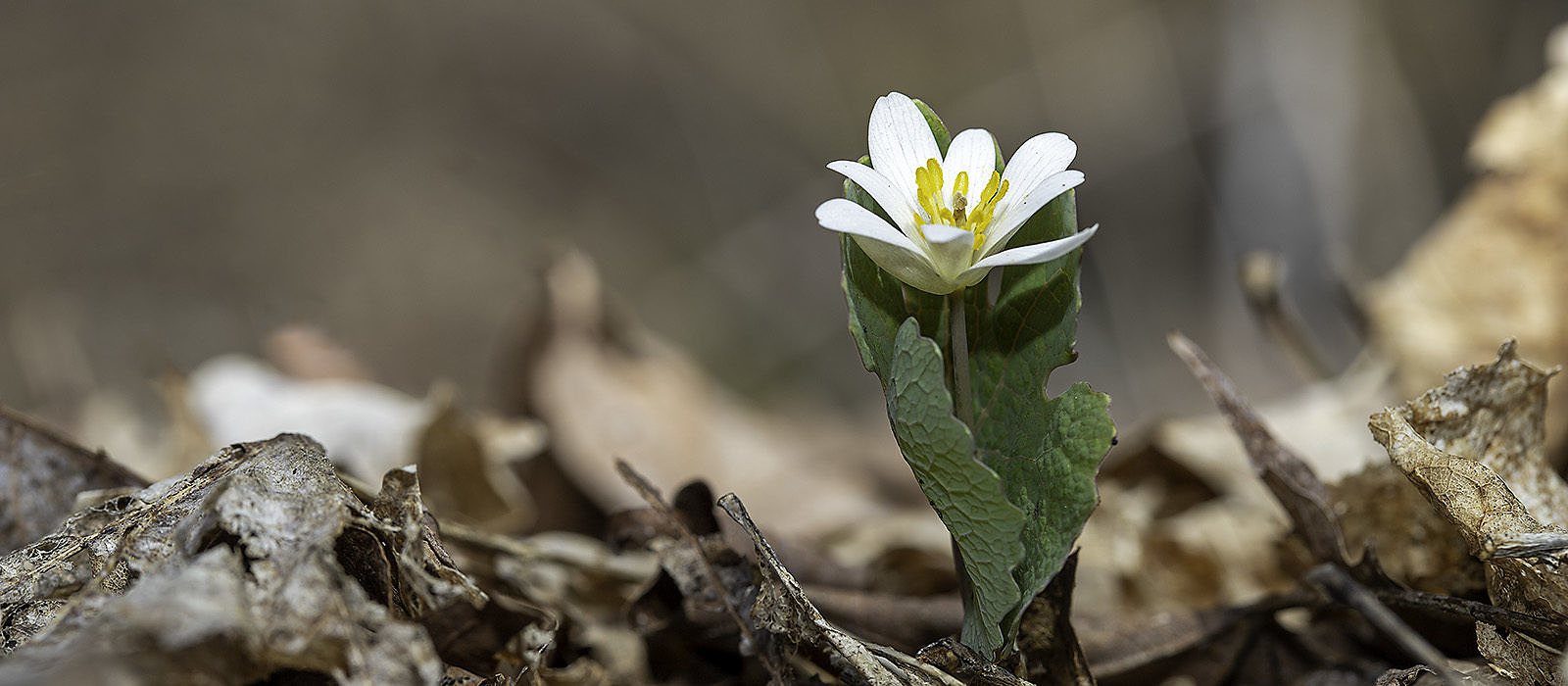
The Audacity of Bloodroot
To Bloom on the Eve of a Snowfall
I suppose all flowers are audacious. After all, they broadcast and beckon to the winds and winged. But the flower of Bloodroot (Sanguinaria canadensis) acts out a game of hide and seek at the intersection of winter and spring.
To be sure, most of nature now dances at this crossroads. The early warbler claims the breeding territory, but might also fly into a Nor’easter. Our first spring butterflies find mates, but little by way of nectar. We ourselves aren’t dissimilar: we plant our vegetable seedlings at risk of killing frosts — an act of ambition and hope.
Bloodroot knows nothing of hope. Like many plants, its flower is supple and sensitive, opening to pollinators by the warmth and light of day, and sealing up in the cold or at night. Botanists call these rhythms nyctinasty.
Yet bloodroot, in the antics of its flower, seems to express both tenacity and trepidation. Unlike Hepatica or Coltsfoot, for example, whose early flowers emerge naked and alone, Bloodroot does a springtime dance with its one and only leaf, which embraces the blossom for a while like a parent.
Anyone who knows me knows of my exuberance for Bloodroot (named for the reddish liquid alkaloid in its rhizomes). And it would be easy — and a predictable brand of nature writing — for me to tell you that this plant, so early to bloom in our woods, offers us an expression of hope in springtime.
Yeah, okay, maybe it’s that. But more than anything, I just like the way this flower and leaf go about their business in April. And I like the grace of those petals once the flower is in full bloom, which stays that way for but a few days. Even a gentle rain can send those pearly petals fluttering the short distance to earth.
On Saturday (25 April 2020), I photographed Bloodroot flowers (pictured below) at various stages of “emergence” in hardwoods here in Montpelier, Vermont. Tentative? Tenacious? Elegant? All of the above.
Audacious? Oh, yeah. Snow in the forecast here tonight.
(Click any image for the expanded view or to start your slideshow.)
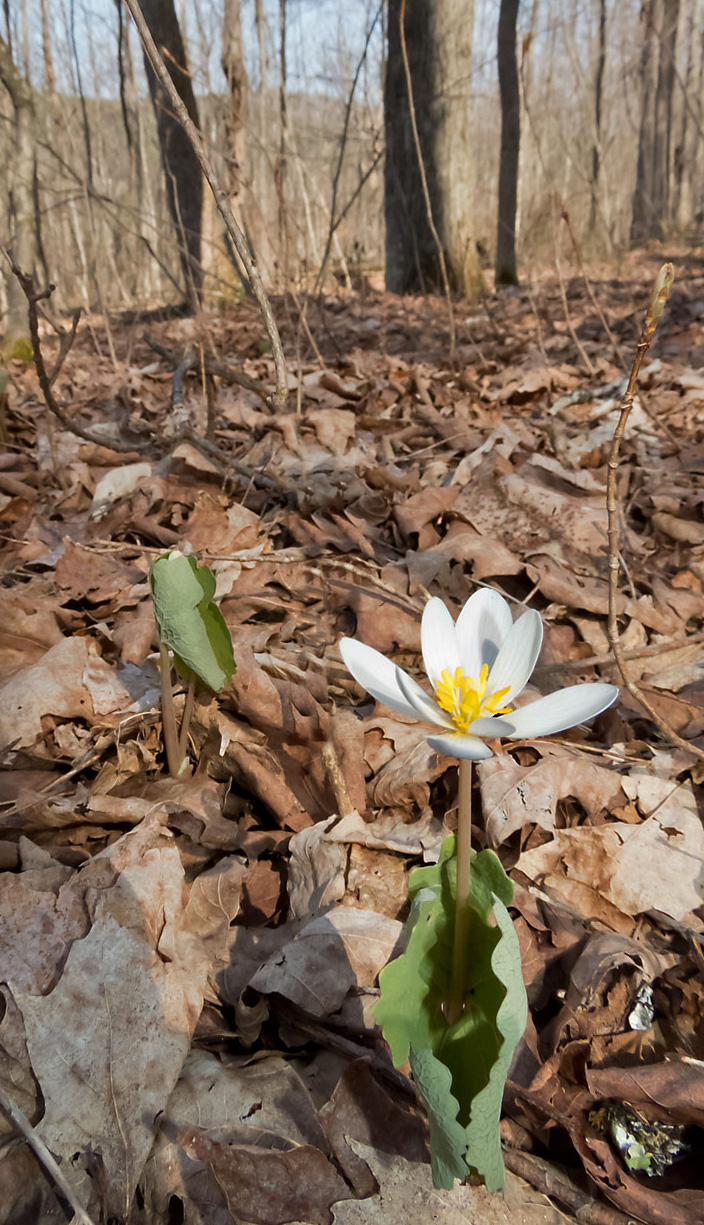
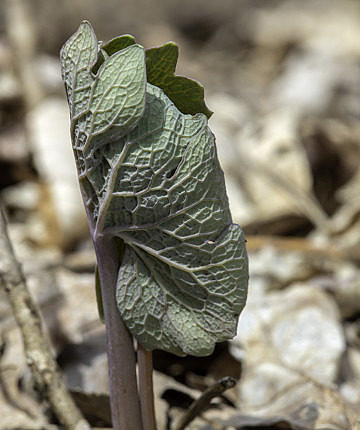
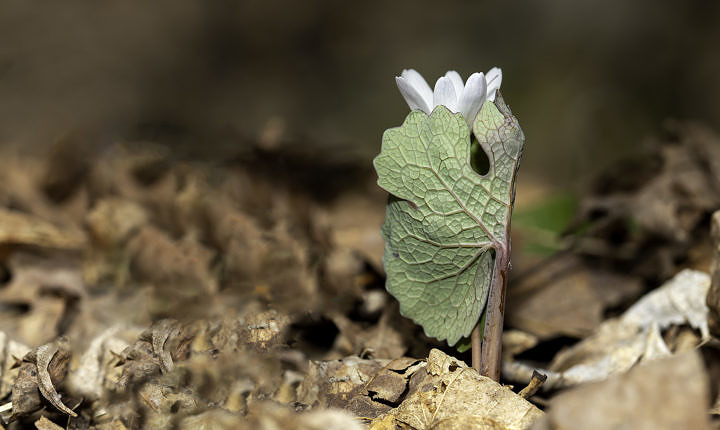
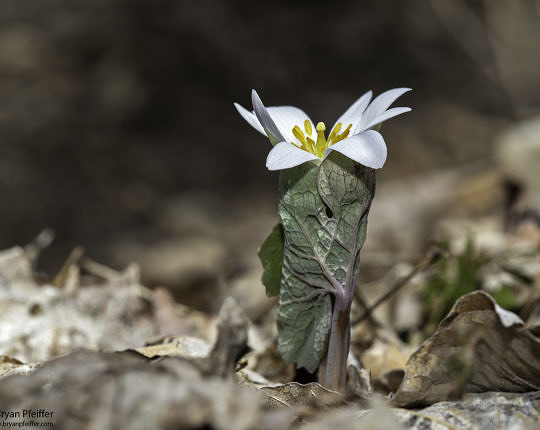
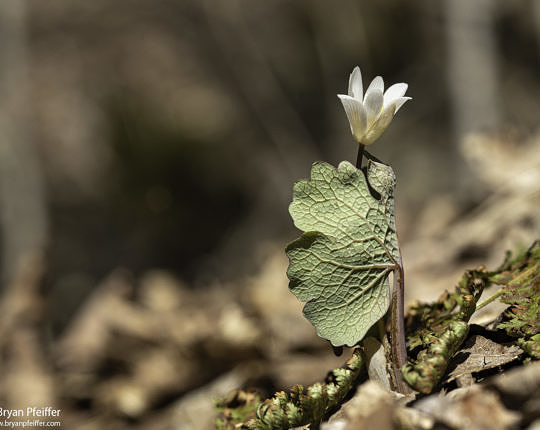
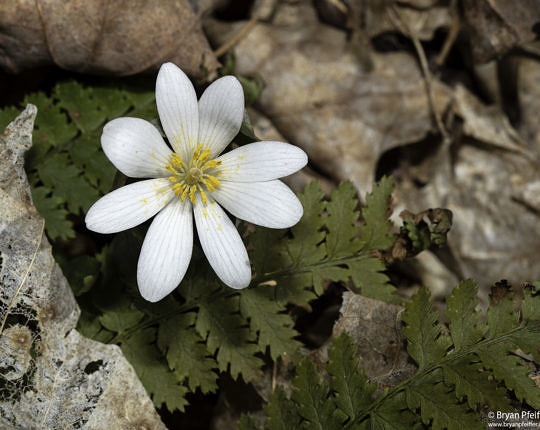
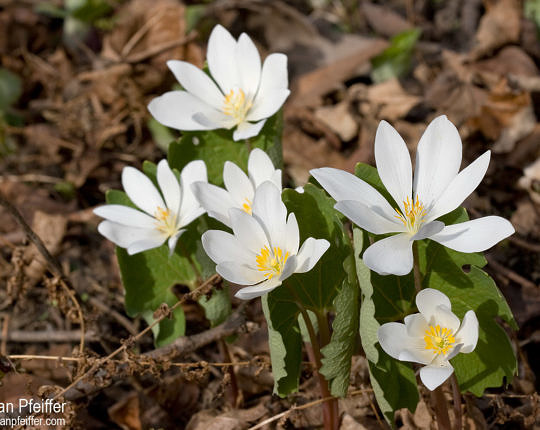





My patch moved an entire 12 plus inches. We disturbed some of the soil within several inches and I think that’s why it migrated
I loved discovering bloodroot on the hill behind our Montpelier house! Every year I found more in different places. Such a lovely plant.
Love it, Louis: “patches of un-melted spring snow…” Thanks!
Thanks, Colleen. We’re in Bloodroot prime time now!
Yes, I think we have to check the literature on this, Martha. I’ll try to carve out some time for it.
Watch out for Compton Tortoiseshells as well, Judy. Good year for them so far!
Hi Bryan,
Went for a walk today at Meach Farm in Shelburne and there in the leaf litter were Bloodroot! This has been a hard winter and harder early spring. If Bloodroot has made it through, I can make it a little longer. Who knows what might show up—like the Mourning Cloak butterfly on the Ticonderoga Tow Path in Shelburne last Thursday.
Ever since my childhood I have loved bloodroot. However I, too, have been puzzled that they seem to move around a bit. This year I am going to mark their spot to see if this is actually true or if my perception is playing tricks on me. I was interested that someone else has thought the same thing!
I was out scouting for Fiddleheads and came upon a nice “clutch” of these yesterday along the Otter Creek in Wallingford.
Good morning, Bryan,
Your photographs and essays are seasonal treats. Superb, clear photographs. We have two “colonies” of Bloodroot planted in our yard, and each year the clusters seem to double in size and numbers. Extraordinary white with yellow punctuation blossoms in the middle of each blossom. They look like patches of un-melted spring snow on the soil.
Louis & Beverly
Wonderful prose and photos. Thank you again and again. I love the dance of Spring in New England. Shy and yet daring.
Wonderful prose and photos. Thank you again and again. I love the dance of Spring in New England. Shy and yet daring. Thank you.
A true sign of spring.
I found Bloodroot along the Kennebec River, south of The Forks, while picking Fiddleheads.
They kind of go together in my way of thinking.
Thanks Bryan for the HOPE you bring us.
Hi Meg, Hmmm. I can’t answer this. They are, of course, rooted in place. (Bloody roots, those Bloodroots.) I’m almost certain they’re perennials. So … I’ll need to investigate.
Yes, you must be at higher elevation. Keep me posted on the phenology!
Bryan… I don’t think I’ve ever really taken full note of the stem of the flower and the leaf surrounding as separate although of course, it seems obvious now. I have a question for you about Bloodroot. Why do they seem to migrate and move around from place to place each Spring. I think I know familiar patches each year but then the following year they’ve moved. They’re really a surprise-party kind of plant!!
Ours is just poking out and not yet unfurled. I never noticed the two stems before – thank you! Funny what a little elevation and shade will do. Maybe by weekend.
Those flowers do go well together. 🙂 Thanks, Brian!
I’ll nominate it! And maybe Lung Lichen (Lobaria pulmonaria) can be the pandemic lichen. 🙂
Hi Anne,
Nice to hear from you. Well, the first thing you’ll need to do is find richer hardwoods, with more calcium in the soil than is usual in that part of Maine. I suspect that if those woods are there near you, the Bloodroot will be blooming soon. But you might have a hard time finding the right habitat. Maine’s soils are simply too acidic out your way. But iNaturalist could be a good source for this. Here are Maine’s Bloodroot records on iNat: https://www.inaturalist.org/observations?place_id=17&quality_grade=research&taxon_id=51044. This might help. Or talk to local botanists who might know. Keep me posted!
We’re in good company among these blooms, Nina — including those double blooms, which I’ve just been discovering. Thanks!
If only I could play guitar like we love those flowers. 🙂
Always nice to hear from you, Sandra. Gosh, it would be great to see you back in Vermont! But enjoy the prairie!
Indeed!
What a wonderful tribute to hope. Maybe the bloodroot can be the official pandemic flower.
Nice. I just spotted some in a roadside ditch out walking this afternoon (southern Ontario, between Toronto and Kingston). Also saw hepatica, yellow trout lily and scilla out there today. Pics made a nice set of four that I posted on Twitter.
Hi Bryan,
Beautiful pictures.
Do you know when I might expect the bloodroot to appear in the western mountains in Maine (Rangeley area)?
Anne
I so love bloodroot-such a shy little spring ephemeral. I have them at various locations on my property, and especially like my cultivated double bloom variety, so that I can have the flower for a few more days. I love the somebody else also appreciates these little beauties.
I should not be in the least bit surprised to find your deep appreciation of my own favorite wildflower! Than k you!
Bryan, I read all your blogs and look at all your photos and look forward to more. Here is Des Moines, IA, blue bells are blooming all over small and large hillsides, they are beautiful to look at. Weather has been good to us, lots of sunshine. Cardinals, red breasted woodpeckers, blue jays, a red- winged black bird singing his usual song on top of a stoplight on a busy road while I was stopped for a red light, a very loud Barred owl two nights ago, turkey vultures galore, all good signs of spring and more coming. Now if we could only get back to a near normal life. Thanks for all you do.
To quote a friend of mine:
” They just pierce your heart.”
I certainly catch my breath at the first sighting of these welcome spring harbinger.
Ha! … and your kids understand, right? 🙂
So nice to hear from you Louis and Beverly. Yep, it’s an extraordinary world indeed — kinda messed up, but still a wonderful place.
Yes, I’m just now learning of these double bloodroots. Lovely! Thanks, Robert!
That is AWESOME news! A bit of Vermont on the Cape!
Thanks, Barbara. I’ve got another image, which I did not include, of a leaf that poked through one of last year’s fallen leave. You know how those often bind up the new leaves. This one is bound up with the flower working its way out. (I like to free up those bound leaves — a human-assisted springtime release.)
I suspect you’ll find them in the Champlain Valley. For sure. Consult iNaturalist for sightings. They’re probably going by in the Champlain lowlands now. But there’s still time!
I love the shots, John! And, for readers, find John’s blog at: https://eaststreetweatherblog.wordpress.com/
Hi Bryan,
I’ve been keeping a close eye on a nice clump of bloodroot that we have down by our brook here in Huntington. It’s been very reluctant to fully emerge this season—no doubt due to the vicissitudinous weather we’ve been experiencing. I’ve been documenting its slow emergence in my East Street Weather blog. Happy to say that most of the blossoms finally opened fully on Saturday.
Cheers,
John
Very cool…thank you……almost like a mother protecting its child…..I don’t see them Here in the Champlain Valley….
Bryan,
Thank you! Your bloodroot pictures are amazing, and the leaf that won’t let go brings a chuckle every time I “leaf” through them again.
Bryan,
Thank you, thank you, thank you! Your bloodroot pictures are amazing, and the leaf that won’t let go brings a chuckle every time I “leaf” through again.
Shhhh, but when I moved, I dug some up to bring to the Cape with me. It survived for many years until an invasive took over. But to my surprise, this year I noticed two new flowers at least 20 feet away – around the bend and through the brush! Happy spring days are here again!
Lovely photos, Bryan. I’ve long been a fan of these ephemerals too. You may be aware that there is a natural “sport” of this flower that has been in the flower trade at least 40 years, “double bloodroot.” It has twice or three times the number of petals and leaves twice the size of the common wild variety. It’s maybe our most spectacular garden flower, from among hundreds of species. We bought it from a tiny mail-order garden center in Wisconsin in 1980, that is sadly now out of business. It spreads slowly but reliably into clumps, some of ours now 4′ across. Truly a spectacular treasure.
Bryan, your article and photographs about the miraculous bloodroot was superb. We also appreciate your excellent photographs of birds and other wonders of nature. They help Beverly and me appreciate the extraordinary world around us. Thank you.
Louis
I too am a lover of bloodroot. I have often joked that I have more bloodroot pictures on my phone than pics of my kids. A very photogenic plant!
Keep me posted! 🙂
I was happy to see a cluster of bloodroot near my blueberries today. Will check on it after tonight’s snow…
I couldn’t agree more! I really love this plant.
Stunning beauty.